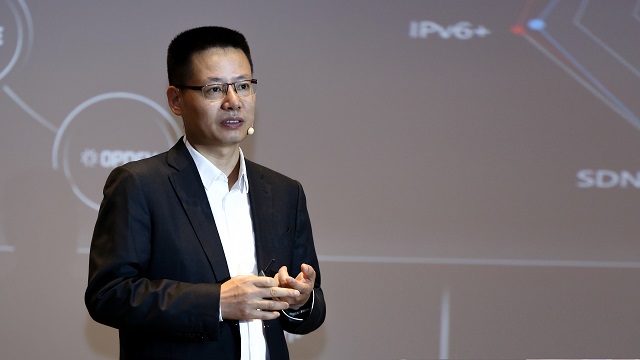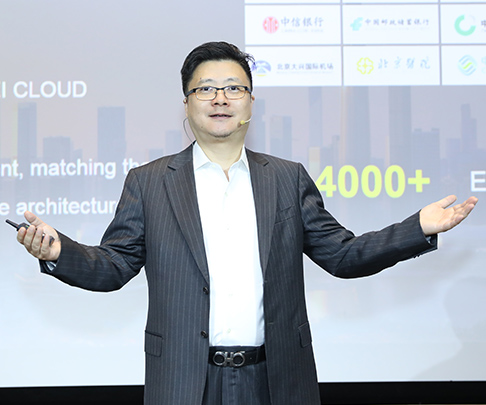Bengaluru, NFAPost: During Huawei Global Analyst Summit 2020, Huawei’s “Leading Intelligent IP Networks, Accelerating the Transformation Towards Intelligent Connectivity” summit discussed on intelligent IP network.
The summit which happened in Shenzhen shed light on three typical characteristics of intelligent IP networks: super capacity, intelligent experience, and autonomous driving.
Besides this, Huawei shared its numerous success stories of intelligent IP networks across industries, signifying the data communications industry’s arrival in the intelligent IP network era.
As 5G, cloud, and AI pick up pace among enterprises of all sizes, enterprises, amid their pursuit for digital transformation, are confronting once-in-a-generation challenges, such as collaboration between hundreds of billions of production and office terminals, 100% migration of enterprise services to the cloud, and 97% AI adoption rate.
As a decisive part of enterprises’ digital transformation, IP networks are also encountering a wide range of issues typified by insufficient bandwidth, poor service experience, and low efficiency of network O&M and troubleshooting. Intelligent IP networks are the key to conquering such issues. To better understand what kind of network can be called an intelligent IP network, Huawei took the lead by defining three typical characteristics of such a network:
1. Super capacity: IP networks achieve a future-proof shift from 100GE to 400GE and from Wi-Fi 5 to Wi-Fi 6, and transform towards intelligent IP networks, boosting bandwidth resources. In addition, such future-oriented networks adopt slice-based bandwidth isolation, implementing flexible bandwidth adjustment.
2. Intelligent experience: Intelligent IP networks stand out with intelligent identification of service types, service intent inference, and flexible, real-time network resource adjustment upon cloud changes. These highlights deliver always-on network connectivity experience.
3. Autonomous driving: Intelligent IP networks can be automatically deployed, achieving rapid adjustment of services. In addition, they can perform automatic, AI-powered fault rectification, implementing proactive O&M and ensuring high network availability.

President of Huawei’s Data Communication Product Line President Kevin Hu said 2020 is the first year for commercial use of intelligent IP networks.
“The entire industry has witnessed an historic shift of IP networks from Internet IP in the World Wide Web era to video-driven All IP, and is now on the way to intelligent IP oriented at the 5G and cloud era. Looking ahead, Huawei will keep innovating and continuously, proactively increasing investment in super capacity, intelligent experience, and autonomous driving to build end-to-end (E2E) intelligent IP networks for customers,” said President of Huawei’s Data Communication Product Line President Kevin Hu.
Huawei’s innovative intelligent IP network solution achieves a future-proof integration of the three characteristics, and has embraced wide applications in various scenarios, such as campus network, data center network, and wide area network (WAN) scenarios.
Specifically, this feature-rich solution is perfectly suited to building high-quality campus networks. It adopts Huawei’s industry-leading AirEngine Wi-Fi 6 that stands out for exclusive 16T16R smart antennas, delivering up to 1.6 Gbps single-user performance (20% higher than the industry average).
Another highlight of Huawei’s AirEngine Wi-Fi 6 lies in AI-powered intelligent radio calibration that improves the average downlink rate of stations (STAs) by more than 50%. The solution also employs an AI-powered intelligent O&M system that slashes the mean time to repair (MTTR) from four hours to as short as just 10 minutes. These differentiators significantly optimize user experience, helping build future-proof, fully-wireless, and intelligent campus networks in an extensive range of scenarios, such as Huawei’s super-large campus serving 194,000 employees, and the digital warehouse of SONGMICS — the largest home necessity seller on Amazon in Germany.
Data centre network
The solution also performs well in the data center network domain. It adopts Huawei’s innovative iLossless algorithm that ensures zero packet loss on the Ethernet, thereby improving data computing efficiency by 27% and data storage efficiency by 30% compared with the industry average.
The Huawei solution also achieves AI-powered intelligent O&M, which can remediate a typical fault in just 9 minutes — fault detection in 1 minute, fault locating in 3 minutes, and fault rectification in 5 minutes. Such superb performance has attracted more than 40 Internet service providers (ISPs) and financial service customers, such as China Merchants Bank, China CITIC Bank, and People’s Insurance Co. (Group) of China Ltd. (PICC).
Besides the campus network and data center network domains, this solution is also highly suited to the WAN domain for its industry-leading FlexE-based slicing that provides 100% bandwidth assurance, achieving 5 times higher slicing granularity than the industry average.

In addition, this feature-rich solution uses IPv6+ to select the optimal path based on the service intent, ensuring committed latency for key services. As such, this solution achieves superb transmission of key services and has been widely applied in multiple scenarios, such as China Mobile (smart grid services), Agricultural Bank of China, and China Unicom Beijing branch (services for the Beijing Daxing International Airport).
Capitalising on more than 20 years of expertise in the IP network domain, Huawei keeps on building highly competitive intelligent IP network products and solutions, as well as providing smooth, continuous services for carriers and customers in the financial services, government, transportation, and energy sectors in more than 100 countries and regions.
Looking forward, Huawei’s Data Communication Product Line will collaborate with more customers in innovative design and in-depth service cooperation to help more customers achieve digital transformation so as to better embrace the “5G + cloud + AI” era and build intelligent IP networks with continuous leadership.
Huawei Advances Computing Strategy and Industry Ecosystem Initiatives
At the 17th Huawei Global Analyst Summit, Huawei announced that it would advance its computing strategy with the industry ecosystem, and foster an ecosystem with computing and HUAWEI CLOUD to cultivate the fertile ground for the digital world. Huawei has and will continue to promote the industry ecosystem and innovate technologies and products. In 2020, Huawei will invest USD200 million in the computing ecosystem and develop 2 million developers worldwide.
Patrick Zhang, Senior Vice President of Huawei and Director of Strategy and Industry Development Department, Cloud & AI BG
By innovating products and solutions and optimizing business models, Huawei is dedicated to cultivating the fertile ground, where partners can develop more applications and fully tap into data value for business benefits. The Huawei ecosystem innovation centers, jointly built with industry partners, are the regional catalysts for computing industry incubation, including best practices showcase, industry chain enablement, industry solution incubation, computing talent development, innovative enterprise cultivation, and application innovation.
In recent years, the Huawei cloud and computing industry ecosystem is thriving thanks to global collaboration. For example, HUAWEI CLOUD has more than 10,000 consulting partners, and the number of technology partners for HUAWEI CLOUD and ISVs in computing has exceeded 3,500. Moreover, 37 ecosystem innovation centers have been established around the world. Over 5,000 cloud applications and Huawei-certified solutions have been rolled-out, which are all provided by our partners of HUAWEI CLOUD and computing.
The new digital infrastructure driven by cloud, AI, and 5G is a new engine for the global economy. In particular, cloud is the key to unleashing the potential of AI and driving robust economic growth. The continuous innovation has made HUAWEI CLOUD the first choice for digital and intelligent transformation of governments and enterprises, bringing shared business success for customers and partners.
Huawei aspires to offer diversified, abundant, and more affordable computing for ubiquitous cloud and pervasive intelligence. According to the Ubiquitous Computing Power: the Cornerstone of an Intelligent Society, a report released by Huawei, the per capita computing power is highly correlated with the economic development. For example, in the traditional manufacturing industry, the investment of 1 US dollar in computing power can increase the output value by 10 dollars.
Since the release of the overall computing strategy in 2019, Huawei has achieved rapid growth in the cloud, computing, and data infrastructure fields.
l Cloud: Huawei capitalises on the synergy of cloud, AI, and 5G to offer stable, reliable, and sustainable public cloud services and hybrid cloud solutions running on innovative full-stack technology. To date, HUAWEI CLOUD has launched over 210 cloud services of 23 categories and more than 190 industry-specific and universal solutions. It also operates 45 availability zones (AZs) with partners in 23 regions. In recent years, HUAWEI CLOUD has maintained stable service growth that empowers its fast development. Its IaaS offering ranked top 3 in China and top 6 in the world in 2019, boasting the fastest growth among all service providers. In March 2020, ModelArts Pro, the first-ever AI app development suite for enterprises, went live on HUAWEI CLOUD to supercharge industry AI. Going from strength to strength, Huawei released the government and enterprise strategy in May, and launched HUAWEI CLOUD Stack series products, which aim to become the first choice for government and enterprise intelligent upgrade. Running on the QingTian Architecture, HUAWEI CLOUD, HUAWEI CLOUD Stack, and HUAWEI CLOUD Edge share the full-stack infrastructure for capability upgrade. The all-scenario QingTian Architecture supports cloud-edge-device collaboration, unified experience, and a unified ecosystem, fueling the intelligent transformation of government and enterprise customers in the digital age.
l Computing: Huawei is committed to unleashing diversified computing power based on x86, Kunpeng, GPU, and Ascend. For general computing, Huawei provides a broad product portfolio, such as integrated equipment, motherboards, and cards. To accelerate AI computing, Huawei launches the powerful Atlas series products. Thanks to the diversified product lineup, the computing device shipments of Huawei registered a year-on-year growth of 8% in 2019.
l Data infrastructure: Huawei focuses on building an OceanStor data storage system powered by innovative algorithms and architectures. Huawei also works with industry partners in the fields of big data and databases to create the converged, intelligent, and open data infrastructure, where the data value can be maximized at the optimal cost throughout the lifecycle. Currently, Huawei storage serves over 12,000 customers around the world, with a 39% compound average growth rate (CAGR) of global revenue. In 2019, the market share of Huawei in both all-flash and mass data storage fields grew up over 50%.
For more information, please visit Huawei online at www.huawei.com or follow us on:





